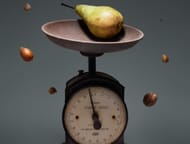What is a calorie? Well, if you’ve ever thought about losing weight or gaining muscle, you must have come across the term.
It’s the most commonly used word in the fitness industry. In fact, whichever type of physique you desire will boil down to training and diet. So, let’s learn more about it.
What is a calorie?

Calorie is the measurement of energy content in food. In other words, the body consumes this via food, which in turn is used as energy for the body to function.
Every physical activity, even breathing, requires energy. This energy comes from the caloric content of consumed food items, which is an extremely important theory in fitness. There are two terms that make the foundation for the subject - surplus and deficit.
What is a surplus?
Every individual needs to consume a particular number of calories per day to maintain their current bodyweight. A surplus means you’re consuming more than your maintenance level.
What is a calorie deficit?
A deficit means that your consumption is lower than your maintenance level.
How to use calories to lose weight?

First, understand the following:
A surplus is used when you want to gain weight or add muscle mass, while a deficit is used when you want to lose weight and cut body fat percentage.
It so happens that the body stores calories in the form of body fat. When following a deficit diet, the body uses stored caloric content to generate the energy needed to reach the maintenance level. As a result, the stored caloric content decreases, leading to a reduction in body fat percentage.
This is how you can use caloric deficit diet to lose weight.
While on the subject of weight loss, you must be aware of hitting a plateau when you’re on a deficit diet. It so happens that there comes a point when the body gets used to the deficit and stops burning the stored fat for energy. That means you have hit a plateau.
To break out of it, increase your food intake for a couple of weeks or a month. Once your body gets used to it, reduce it again. That way, the body will again burn the stored caloric content to reach the maintenance level.
What should my calorie intake be?

Now that you know the concept of being in a deficit, you need to understand how to calculate your maintenance and figure out your deficit.
As every individual will have a different maintenance levels based on their height, weight, metabolism, activity levels, and others, you must not follow someone else’s diet blindly.
First, figure out your maintenance. There are several online calculators that can help you understand that. Second, deduct 500 (moderate) or 700 calories (aggressive) from it. That number is your deficit.
Third, figure out your daily macros i.e., figuring out how much protein, fat, and carbohydrates will make up your diet. Fourth, create a diet to match the macros and required caloric content as per your food preferences.
However, you can add all the types of food you like due to a concept known as 'empty calories'.
What are empty calories?

You must also note that not all food items you prefer will have nutritional value. Some food items or beverages have no nutritional value, and essentially you end up consuming items with empty caloric content.
The idea behind these foods and beverages is that they're great for providing you with an immediate burst of energy, but it doesn’t provide you with the macros required for your diet. Certain examples are soft drinks, fruit juice, herbal teas, doughnuts, ice-cream, etc.
What is the highest calorie food?
Ideally, you won’t be able to judge the food with the highest caloric content, as everything should be consumed in moderation. However, if you were to pick the same amount of chicken and potatoes, one would have more caloric content than the other.
Certain items such as oil, carbohydrates, and red meat are some food items that have a high caloric content when compared to others.
